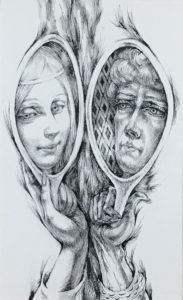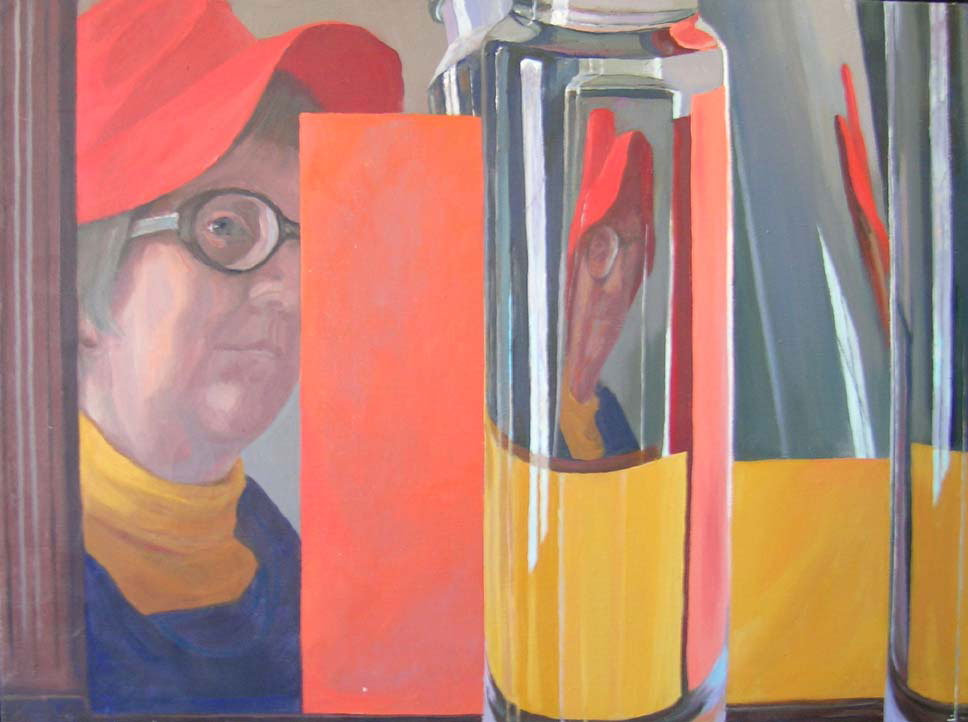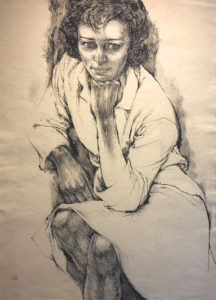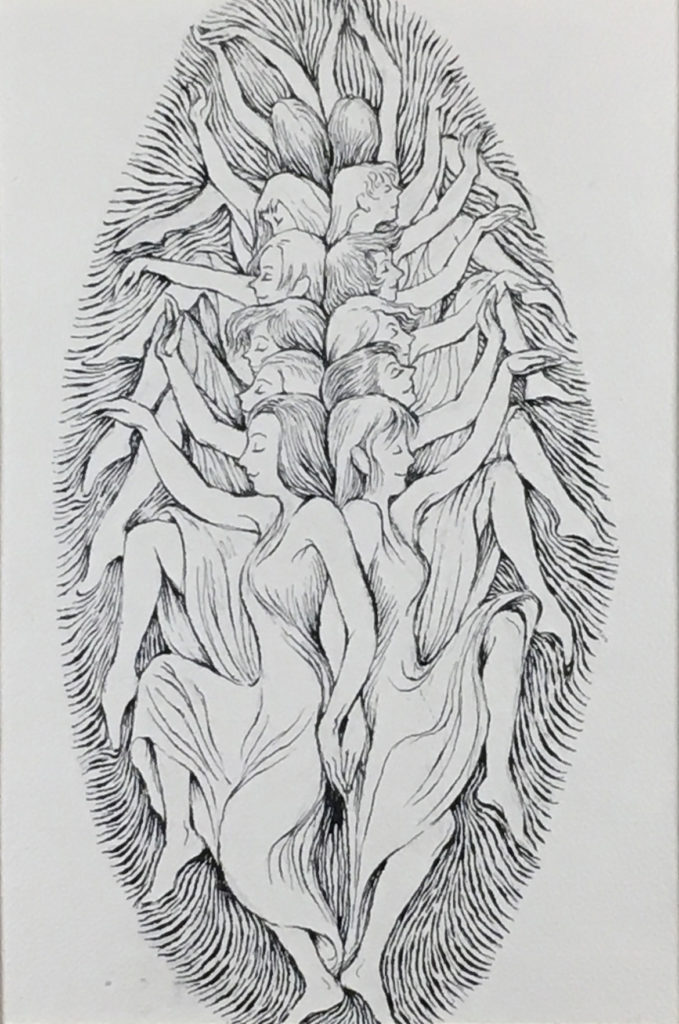“I was able to do something maybe wilder than I would have on my own,” the Boston artist Barbara Swan would say about her illustrations for Pulitzer Prize-winning Boston poet Anne Sexton’s 1971 book of poems inspired by the fairy tales of the Brothers Grimm.
In this book, “Transformations,” Sexton reimagines the old folk stories for the feminist 1970s. Her poems are observational and acid and witty. She begins with pointed interludes about society, then retells the fairy tales with contemporary references and snarky asides and probing “psychological relationships” (as Swan put it).
“Inside many of us / is a small old man / who wants to get out,” Sexton writes in “Rumpelstiltskin.” “He is a monster of despair. / He is all decay. / He speaks up as tiny as an earphone / with Truman’s asexual voice: / I am your dwarf. / I am the enemy within. / I am the boss of your dreams.”
Swan’s interpretations in scratchy pen accented with a bit of gray wash—featured in “Barbara Swan: Drawings for ‘Transformations’” at Boston’s Alpha Gallery through Feb. 28—are intimate and barbed and funny.

An old witch hugs the young Rapunzel, who she’s imprisoned (Sexton depicts them as lovers), close to her. (Pictured at top.) Red Riding Hood’s woodsman presses his ear to the grandmother-wolf’s belly to detect traces of the grandmother and girl swallowed inside. The Twelve Dancing Princesses sneak off for midnight revels in a composition that might suggest lady parts. Snow White and her queen stepmother rival each other in the magic mirror.
“Her stepmother / a beauty in her own right, / though eaten, of course, by age, / would hear of no beauty surpassing her own,” Sexton writes in “Snow White and the Seven Dwarfs.” “Beauty is a simple passion, / but, oh my friends, in the end / you will dance the fire dance in iron shoes.”
“There’s a sort of dramatic theatrical sense of confrontation … in the Queen and little Snow White, between the aging beauty and the young beauty, and this is a universal theme,” Swan said in Smithsonian Archives of American Art oral history interviews in 1973 and ’74. “She sent me ‘Snow White’ and the minute I read it, I called her up and I says, oh, my God, Anne, I says, I love that poem, and I says I’ve got to tell you I identify with that poor old queen and Anne says so do I.”
Swan says in her drawing “you get the old queen and she’s—I put, you know, false eyelashes and she’s been to the hair dresser. She’s got every part going for her. On the other hand, to me, Snow White is terribly smug and complacent and all she’s got going for her is she’s so damn young, you know.”
Help Wonderland keep producing our great coverage of local arts, cultures and activism by contributing to Wonderland on Patreon. And sign up for our free, weekly newsletter so that you don’t miss any of our reporting.

Swan (1922-2003) was born in Newton. She studied art history at Wellesley College, then art-making at Boston’s School of the Museum of Fine Arts from 1943 to ’47. There she became steeped in the abject Boston Expressionism of Karl Zerbe, the head of the painting department (she was his teaching assistant during her fifth year), and other teachers there—the subjective views, the emotional color, the agitated brushwork, the warped realism, the continued interest exploring the psychology of people.

Many of Swan’s artworks from the 1940s and ‘50s were portraits of friends and family. She liked to begin with the eyes and work out. Unusual for the macho, male-dominated American art world of the time, she sometimes places you in a mother’s perspective—as in her 1956 painting “The Nest,” a self-portrait gazing down from above her head as she nurses her infant son.
During the 1960s, her style became cooler as she embarked on a long series of still-life paintings of tall cylindrical bottles filled with water, a classic painting subject to explore and toy with perception and realist rendering. She depicted the ways glass and water become lenses warping our vision of people, dolls, eggs, striped fabric and pictures (Renaissance paintings, Edvard Munch, 19th century American scenes, magazines). She also seemed to contemplate women and sexuality in our society in charged still-lifes of naked dolls, old timey erotica and vintage gossip magazines that became surreal scenes when looked at through the warping lenses of her bottles in paintings like “Inner Life” (1977), “Blonde Hussy” (1986) and “Les Femmes” (1990).
Swan met Sexton (1928-1974) when they were both part of the first group of Bunting Fellows at the Radcliffe Institute for Independent Study (now the Radcliffe Institute of Advanced Study Harvard University) in Cambridge in the early 1960s. The idea seems to have been to foster collaboration between women in differing fields.

“She’s a confessional poet and we have this great rapport because we understand this gut thing between the human and the human condition,” Swan said in Smithsonian Archives of American Art oral history interviews in 1973 and ’74.
Their first collaboration may have been a poster or broadside built around Sexton’s poem “For The Year Of The Insane.”
“She has had a great deal of emotional trauma. She’s been institutionalized. She’s had breakdowns and this is all very much in her poetry,” Swan said. (Sexton would commit suicide in 1974.)
In the introduction to “Transformations,” Kurt Vonnegut wrote: Anne Sexton “domesticates my terror, examines it and describes it, teaches it some tricks that will amuse me, then lets it gallop wild in the forest once more,”
Swan said, “I make out fine collaborating with her because, you see, my work, if you look around, you know, there’s this kind of haunting sense of personal and tragic sense in some of my prints and—and the kind of human relationship which is full of a certain kind of haunting anguish. So when I moved into Anne’s world, I found that it was very—I was comfortable dealing with that kind of image.”
Help Wonderland keep producing our great coverage of local arts, cultures and activism by contributing to Wonderland on Patreon. And sign up for our free, weekly newsletter so that you don’t miss any of our reporting.

